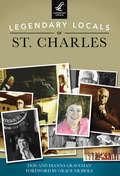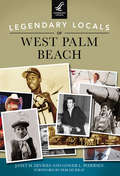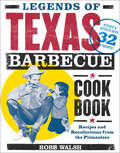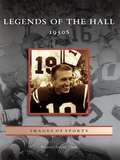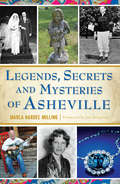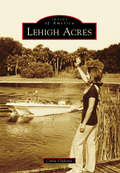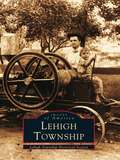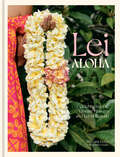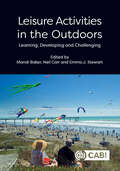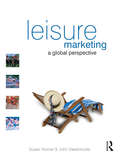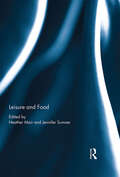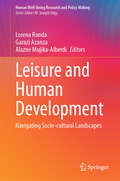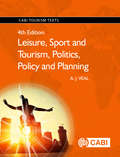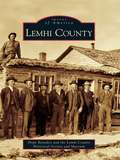- Table View
- List View
Legendary Locals of St. Charles (Legendary Locals)
by Grace Nichols Don Graveman Dianna GravemanToday's citizens of St. Charles will recognize the names of many early settlers and residents, such as Louis Blanchette, who founded the settlement that would later become St. Charles; St. Rose Philippine Duchesne, who helped found the first school of the Society of the Sacred Heart in America; and Lewis and Clark, who began their expedition here to explore the Louisiana Purchase territory. Later came photographer Rudolph Goebel, who chronicled St. Charles's history for more than 50 years; Jane Crider, advocate for adults with disabilities and cofounder of Boone Center Inc.; and Archie Scott, known as "Mr. Main Street" for his years of dedication to the preservation of the historic district. Included in Legendary Locals of St. Charles are businesspeople, local personalities, authors, and entertainers, and while some of them may not yet be legendary, all of them are notable for their contributions to the St. Charles community and beyond.
Legendary Locals of St. Joseph and Benton Harbor (Legendary Locals)
by Elaine CotsirilosA cast of characters tumbles out of the pages of this book, beginning with the courageous settlers who tamed the wilderness. By the 1890s, dynamic denizens of St. Joseph and Benton Harbor harvested fruit, established factories, and opened tourist attractions. Drake and Wallace’s Silver Beach Amusement Park, with its roller coaster, fun house, and Lake Michigan beach, attracted visitors from Chicago. So did the curative mineral waters. Al Capone took “the baths,” despite their stinking like rotten eggs. The Israelite House of David, a Christian sect founded by Benjamin and Mary Purnell, welcomed summer visitors to their amusement park. Despite an infamous scandal and trial involving Benjamin, the House of David thrived for decades. The cities spawned inventors like Augustus Herring, who flew an airplane five years before the Wright brothers; Emory Upton, who developed an electric-powered washing machine manufactured by a company now known as Whirlpool; and Walter Miller, inventor of a record-changing machine manufactured by V-M. By the 1980s, manufacturing in the area had declined, and the cities suffered. Present-day entrepreneurs, artists, and community activists have jump-started their return to vitality.
Legendary Locals of West Palm Beach (Legendary Locals)
by Janet M. DeVriesFrom West Palm Beach's beginnings as service town to Palm Beach, Standard Oil tycoon Henry Morrison Flagler's resort village, the city has evolved into a trendy art, cultural, and shopping mecca. Palm Beach County's largest city serves as county seat and center of business, government, and commerce. Taming America's last frontier saw the industriousness of pioneers and settlers such as Marion Gruber, the Potter brothers, George Lainhart, and Max Greenberg guide the "Cottage City" of yesteryear to today's gleaming metropolis. Meet many of West Palm Beach's pioneers, civic leaders, educators, business leaders, and entrepreneurs. Learn about the heroes, celebrities, philanthropists, and even the villains who have contributed to the mosaic of West Palm Beach.
Legends & Lore Along California's Highway 395 (American Legends)
by Brian CluneStretching from Victorville to Carson City, Highway 395 offers a snapshot of California's diverse landscapes and oddities. Tales of skinwalkers and Sasquatch sightings flourish among the bones of ghost towns, and stories of the elusive Lone Pine Mountain Devil ignite the curiosity. Far from fiction, the Sierra Phantom lived among the hills for fifty years, and mountaineer Norman Clyde used his skills to find lost hikers and climbers. Rumors of the Lost Cement Mine, with a rich vein of gold, lure people in, and the Tuttle Creek Ashram, built high above Lone Pine, offers peace. Author Brian Clune explores the strange and fascinating side of the majestic mountains and lonely deserts along US 395.
Legends & Lore of Cape Cod (American Legends)
by Robin Smith-JohnsonCape Cod has a rich tradition of local lore, stretching back to a time before the Pilgrims arrived. Ancient Wampanoag legends like Granny Squannit and Princess Scargo are as familiar as tales of pirates and explorers, including "Black Sam" Bellamy and Donald Baxter Macmillan. Felines often blocked "Cat's Alley" in pursuit of food from fishermen's boats. The remnants of Billingsgate Island can be seen at low tide, and visits from Jenny Lind and Helen Keller contrast with the mysterious stories of the "Lady of the Dunes" and New England's Dark Day. Author Robin Smith-Johnson shares historic tales of shipwrecks, murders, hauntings and more from the Cape.
Legends & Lore of East Tennessee (American Legends)
by Shane S. SimmonsThe mountains of East Tennessee are chock full of unique folklore passed down through generations. Locals spin age-old yarns of legends like Davy Crockett, Daniel Boone and Dragging Canoe. Stories of snake-handling churches and the myths behind the death crown superstitions dot the landscape. The mysteries surrounding the Sensabaugh Tunnel still haunt residents. Author Shane Simmons explores tales of bravery, lore and bizarre customs within the East Tennessee region.
Legends of Hollywood Forever Cemetery
by E. J. Stephens Kim StephensFounded in 1899, scenic Hollywood Forever Cemetery—the only cemetery located within the city of Hollywood—serves as the “permanent home” for many of Hollywood’s most famous (and infamous) characters. Hollywood Forever Cemetery boasts a fascinating history surpassed only by the compelling stories of its famous residents. Behind its iron gates are the graves of Cecil B. DeMille, Rudolph Valentino, Douglas Fairbanks, Carl “Alfalfa” Switzer, Tyrone Power, Nelson Eddy, Marion Davies, Fay Wray, Mel Blanc, Johnny Ramone, Don Adams, Bebe Daniels, Bugsy Siegel, and a host of others whose memorials tell the history of Tinseltown in stone.
Legends of Texas Barbecue Cookbook: Recipes and Recollections from the Pitmasters (Legends Of Texas Ser.)
by Robb Walsh“[A] collection of barbecue memoirs, trivia and history . . . Walsh interviews the top pit bosses across the state and shares their secrets.” —Publishers WeeklyIf barbecue in Texas is a religion, this book is its bible. Originally published only in print in 2002, this revised and updated edition explores all the new and exciting developments from the Lone Star State’s evolving barbecue scene. The one hundred recipes include thirty-two brand-new ones such as Smoke-Braised Beef Ribs and an extremely tender version of Pulled Pork. Profiles on legendary pitmasters like Aaron Franklin are featured alongside archival photography covering more than one hundred years of barbecue history. Including the basic tools required to get started, secrets and methods from the state’s masters, and step-by-step directions for barbecuing every cut of meat imaginable, this comprehensive book presents all the info needed to fire up the grill and barbecue Texas-style.“In 2002, Robb Walsh’s Legends of Texas Barbecue Cookbook hit the sweet spot for lovers of smoked meat. The book was part travelogue, part instruction manual, with a side of history thrown in . . . If your old copy is worn, tattered and splashed, it’s time to trade up. If you are late to the barbecue and don’t know the likes of Bryan Bracewell, Vencil Mares and Lorenzo Vences, consider it an investment in your education.” —The Dallas Morning News“Robb Walsh has been there to help shape and document the evolution of Texas barbecue. This new edition is a must-have.” —Aaron Franklin, James Beard Award–winning pitmaster
Legends of the Hall: 1950s (Images of Sports)
by Kristine Setting ClarkLegends of the Hall: 1950s captures a period of time when playing professional football was for tough, honest men who played solely for the love of the game. The 1950s was an era of crew cuts and nicknames like Crazylegs, Hopalong, and Night Train. The decade began with Sammy Baugh throwing his last passes and ended with the death of Bert Bell. This era also produced some of the greatest quarterbacks ever to play the game. They were known as the glamour boys of the league--Otto Graham, Bob Waterfield, Bobby Layne, Y. A. Tittle, and Bart Starr, to name a few. The incomparable, individual brilliance and unique team chemistry that marked this era have transcended this specific time and place to make Legends of the Hall: 1950s an unforgettable part of the magic and myth of professional football.
Legends, Secrets and Mysteries of Asheville
by Marla Hardee Milling Foreword By SchochetBeyond the beaten path of local landmarks, residents and tourists can find curious secrets, lost mysteries and fascinating legends. The famed Hope Diamond once found itself, and its mysterious curse, buried in an Asheville girl’s sandbox. Elvis once handed a cherished guitar to a local man at an Asheville concert, and he held on to it for forty years. At a flea market, an Asheville attorney paid a few bucks for an old tintype likely of Billy the Kid, and it may be worth millions. Native author Marla Hardee Milling recounts odd, but true, stories hiding behind Asheville’s picturesque beauty.
Lehigh Acres
by Carla UlakovicLehigh Acres emerged from an expanse of southwest Florida's wild lands due to the vision of industrialist, inventor, and self-made millionaire Leonard Lee Ratner and his business partners in the Lee County Land and Title Company. For Ratner, southwest Florida represented a land of opportunity. In 1952, he purchased Lucky Lee Ranch in eastern Lee County as a means to maintain his fortune; however, a chance meeting in Miami with Gerald Gould, a young advertising executive, forever changed the future of this Florida ranchland. They formed a company, began subdividing the land, and devised a marketing plan to attract buyers from the Midwest and Northeast by selling dreams in "a golden land of opportunity" and touting an average temperature of 74 degrees. Soon, roadways, model homes, the Lehigh Acres Country Club and Motel, and an ultramodern auditorium brought the community to life. As the decades moved on, the company's holdings grew to 60,000 acres, making Lehigh Acres one of the largest subdivided communities in the nation. Rich in natural beauty, amenities, and activities, the dynamic marketing team convincingly sold many on the idea "that you needn't be a millionaire to live like one" in Lehigh Acres.
Lehigh County (Then and Now)
by Kelly Ann ButterbaughLehigh County has transformed throughout the years and now is a far cry from its rural identity only 50 years ago. Today Lehigh County is known as an important link to the metropolitan areas of New York City and Philadelphia.
Lehigh Township (Images of America)
by Lehigh Township Historical SocietyLehigh Township was settled in the late 1700s by immigrants who had come to work in the numerous slate quarries. Situated in the foothills of the Blue Mountains, the township represented the last signs of civilization for those traveling north from Philadelphia to the wilderness beyond the Lehigh Gap. The township has remained largely rural, with farms and open fields abundant along its two-lane highways.Compiled by members and friends of the Lehigh Township Historical Society, Lehigh Township is a collection of rare vintage photographs of the community. The Cherryville Hotel (which in its heyday was known throughout the area as one of the best places to get Pennsylvania Dutch food), local quarries, one-room schoolhouses, Dieter's Foundry, and the Indian Trail and Edgemont amusement parks make up a sampling of the countless familiar images of Lehigh Township's past. Lehigh Township is an indispensable reference for both residents and visitors.
Lei Aloha: Celebrating the Vibrant Flowers and Lei of Hawai'i
by Meleana EstesExplore Hawaiian culture through the art of lei making with flower inspirations and gorgeous photography from stylist, fashion designer, and local island icon Meleana Estes.Brimming with vibrant photos of the most famous flower garlands of Hawai&’i—the lei—in dreamy island settings, Lei Aloha tells the story of the flowers, craftsmanship, and community of lei culture, offering a window into this beautiful world where life is a little slower, flowers are abundant, and personal connections run deep. Local style icon Meleana Estes continues the legacy of her native Hawaiian grandmother, who was well known for her intricate and stunning lei. Sprinkled throughout the book also are anecdotes about the fascinating history of flowers, lei, and island traditions.Each chapter tells the story of a grouping of flowers and lei, such as plumerias for a sweet gathering of neighborhood keiki (kids), elegant strands of white and yellow ginger for a candle-lit party, or striking lei haku made for hula performances. It&’s an easy craft for the homesteader with roots in a full backyard garden or the digital nomad who keeps her possessions in one suitcase and can pick up flowers on her travels. With evocative photos of vintage mu&’umu&’us, lush tropical gardens, lei-bedecked longboard surfers, striking tablescapes, and graceful hula dancers, Lei Aloha shares a side of the islands that only locals usually get to see.
Leicester
by Leicester Historical Society Leicester Historical CommissionLeicester began as a small Colonial settlement in the early 1700s and quickly blossomed into a flourishing farming community. Located among the headwaters of the Blackstone River, the numerous villages of Leicester prospered during the Industrial Revolution with gristmills, sawmills, and textile mills. By the 1880s, one-third of all hand and machine cards made in North America were produced in Leicester. After the deindustrialization of the twentieth century, the town began to return to its agricultural roots; today, for the most part, it appears largely rural once again. Leicester pays tribute to the industrial, yet rural, and independent, yet cooperative, spirit of this suburb of Worcester.
Leif Eriksson: Norwegian Explorer
by Cynthia Klingel Robert B. Noyed Cynthia Fitterer KlingelA biography of Leif Eriksson: Norwegian Explorer
Leif The Lucky
by Ingri Daulaire Edgar P. DaulaireA biography of Leif Erickson, son of Eric the Red,a famous Viking and early visitor to North America.
Leisure Activities in the Outdoors: Learning, Developing and Challenging
by Mandi Baker, Neil Carr, Emma J. StewartThe benefits of being outdoors in a leisure context are widely acknowledged across a range of disciplinary perspectives (including tourism, therapeutics, education and recreation). These benefits include the development of: health and wellbeing; social skills; leadership and facilitation skills; personal, emotional and reflective abilities; confidence and identity creation. Drawing on a variety of perspectives, geographies and approaches, this book explores the opportunities that leisure in the outdoors provides for learning, developing and challenging. The authors in this collection challenge dominant discourses of outdoor leisure through their selection of outdoor activities, theoretical approaches and modes of representation. All offer fresh insights and thinking into how leisure in the outdoors can be understood. The book covers a range of outdoor conceptualisations that challenge the reader to think deeply and broadly about the common threads which bind the broad field of outdoor leisure together. The experiences explored in this book range from suburban outdoors to wild places, surfing to mindful reflection, and trail walking to Nordic skiing, and encompass a broad spectrum of people. This book will appeal to outdoor scholars from a variety of contexts, including recreation, tourism, and adventure. It provides: ·original and leading research across layers of meaning attributed to and drawn from leisure experiences in the outdoors; ·value in theorising the notions of outdoor experiences; ·a variety and scope of contexts and approaches for students to draw on when learning about the field of outdoor leisure.
Leisure Marketing
by John Swarbrooke Susan HornerDivided into nine parts, Leisure Marketing: a global perspective guides the reader through leisure and marketing concepts, the marketing mix, key issues in different sectors, topical issues (such as globalisation, marketing research and ethics, for example branding and environmental issues), and the future of leisure marketing. A section of the book is devoted entirely to international case studies, which illustrate and highlight key themes and issues raised throughout in order to facilitate learning. Example of international cases used are: Disneyland Resort, Paris: The Marketing Mix Manchester United Football Club: Marketing the Brand The Growth of the Online Retail Travel Market Hilton Head Island, USA: The Leisure Island for Golf and Leisure Shopping Health, Leisure and Tourism Marketing including Spa Hotels, Health Clubs and lake Resorts. This book combines real world experience with a solid theoretical framework. It is essential reading for anyone studying, teaching or working in marketing in the leisure industry.
Leisure and Food
by Heather Mair Jennifer SumnerLeisure and food seem to be a natural fit, but the recent, unprecedented focus on all aspects of food has not been reflected in the field of leisure studies. This book is the first to combine these vital aspects of human interest by exploring the interface between leisure and food in a number of areas. For example, it examines sports nutrition products, which straddle the boundary between junk and food. It also looks into hosting sustainable meals, and what eaters can learn about sustainable food choices and food citizenship. It visits ethnic restaurants and inquires about the authenticity of eatertainment experiences from both the supply and demand side. And it takes up gardening, while investigating questions of food security, social capital, gardening narratives and the role of place. The book concludes with a dynamic reflection that sums up these leisure and food practices and sites, and challenges us to continue these debates.This book was published as a special issue of Leisure/Loisir.
Leisure and Human Development: Navigating Socio-cultural Landscapes (Human Well-Being Research and Policy Making)
by Lorena Ronda Garazi Azanza Alazne Mujika-AlberdiThis edited volume analyses emerging trends in the world of leisure and human development from the perspectives of subjective well-being and policy development. It brings together a diverse group of authors to delve deep into the transformative effects of leisure on human development and the future of sociocultural policy planning related to new directions in the field. Setting itself apart from existing literature, the volume offers a comprehensive view of the multifaceted nature of leisure and its significance in enhancing well-being and personal growth. It explores the emotional richness of leisure experiences, the impact on bridging generational gaps, and the cultural relevance of leisure within various sociocultural settings. This work uncovers the powerful role of leisure in shaping relationships, cultural institutions, and communities, revealing its profound influence on human lives. For those in the fields of practice, policy-making, or research, this book serves as a valuable resource for creating inclusive and meaningful leisure experiences. The volume is an indispensable addition to the literature on the subject, and is of interest to academics, practitioners, or laypersons interested in the dynamics of leisure.
Leisure, Sport and Tourism, Politics, Policy and Planning
by A. J. VealThis comprehensive, multi-disciplinary introduction to public policy and planning as carried out by governments and associated agencies covers the rights of the person as a citizen in terms of their needs and requirements for leisure, travel and sport, and the role of the state and market in meeting these needs. Expanded to include sport as a subject separate from leisure, this new edition of the successful Leisure and Tourism Policy and Planning also addresses the issues of climate change and global warming, which are crucial considerations for tourism planners and policymakers. It covers theoretical perspectives and practical guidelines for the application of a range of analytical techniques, and includes an extensive bibliography and questions and exercises for each chapter, making it an ideal text for students as well as practitioners.
Leisure, Sport and Tourism, Politics, Policy and Planning (CABI Tourism Texts)
by A.J. VealThe gap between theory and practice in the leisure, sport and tourism studies areas seems to have widened as scholars have become more specialized. Nevertheless, it is imperative that students be as familiar as possible with a wide range of social and political theory, and also be able to reconcile that knowledge with their own current and future roles as practicing professionals. A comprehensive, multidisciplinary approach to public policymaking and planning in the leisure, sport and tourism sectors, this book: - examines the theoretical issues underpinning public sector policymaking such as political ideologies, leisure wants, needs, demand and benefits, and human rights in leisure, sport, tourism and culture; - discusses the debates surrounding the role of the state versus market, and models of organizational decision-making; and - uses applied sections addressing strategic planning and performance evaluation to provide a link between theory and practical analytical techniques. As well as extensive updating of sources, this new edition examines such topics as libertarianism, theocracy, anti-establishment politics, and the concept of generations. A new chapter presents discussions of a number of 'issues and challenges' facing the leisure, sport and tourism sector. Introducing the subject for undergraduate and postgraduate students of leisure, sport and tourism, this book is also a useful addition to the shelf of any policy maker or practitioner within the industries.
Leisure, Sport and Tourism, Politics, Policy and Planning 4th Edition
by A. J. VealA comprehensive, multi-disciplinary approach to public policy making and planning in the leisure, sport, and tourism sectors, this book provides an introduction to the subject for undergraduate and postgraduate students. It examines the theoretical issues underpinning public sector policy making such as political ideologies, leisure wants, needs, demand, and benefits, and human rights in leisure, sport, tourism, and culture. Also discussing the debates surrounding the role of the state versus market and the models of organizational decision-making, it uses applied sections addressing strategic planning and performance evaluation to provide a link between theory and practical analytical techniques.
Lemhi County
by Hope Benedict Lemhi County Historical Society and MuseumSituated at the base of the Continental Divide and surrounded by the Lemhi and Salmon River Ranges, Lemhi County, Idaho, provides a fascinating look at the "Old West" as it makes its precarious transition to a new order. Traditional homeland to the people of Sacajawea, Lemhi County became a destination point for Lewis and Clark as they worked their way across the continent, for trappers, for missionaries, and finally, in 1866, for prospectors and those who kept them fed, clothed, and entertained. The community that developed in the valleys of the Salmon, Lemhi, and Pahsimeroi Rivers benefited from long-term mining and the simultaneous evolution of ranching and the timber industry, and this growth was well documented by local photographers.
